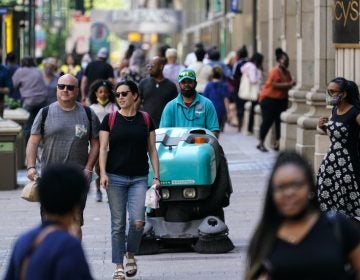Germantown resident: ‘I do remember bulldozers digging up a few bodies’ at Potter’s Field site
Turnout was light at Thursday night’s Philadelphia Housing Authority meeting to discuss the future of the Queen Lane development project and Potter’s Field in Germantown.
Those who attended, however, had questions about how human remains from the historic African American burial ground there would be handled if discovered.
William Steinart had some answers.
A geophysics project manager for Enviroscan Inc., a Lancaster-based geologic firm specializing in examining underground sites without excavation, Steinart will spend the next week at the site with a ground-penetrating radar device.
He described the machine as a essentially “baby buggy with an antenna” and that the radar waves were not dangerous to humans. As for what Steinhart expects to find, it won’t be small artifacts.
“A body size or bigger,” he said, recalling a Virginia project in which slave cemeteries were discovered several years ago. Like here, there were no tombstones to aid in the search. “Anything smaller than that, I’m not going to be able to see.”
Protocol for any discoveries
Joining him will be Mary Alfson Tinsman, director of preservation at Cultural Heritage Research Services, a Landsdale-based archaeological company.
She explained that there are strict guidelines if bodies are discovered.
“If he’s out there testing and he finds a row of graves where Potter’s Field wasn’t, we want to know that now,” Alfson Tinsman said. If a discovery is made, “we will stop the work, bring out an archeology crew, excavate far enough down to confirm that something is there.”
Calls will then be placed to police, the housing authority, a federal Housing and Urban Development branch and the city Medical Examiner’s Office, per the Pennsylvania Historical and Museum Commission guidelines.
She even promised to coordinate with Pastor Nathan Hasty of Mt. Moriah church, which has hosted the community meetings.
But the first goal, she explained, is to define the boundaries of the Potter’s Field, or what’s believed to have been used as an African American burial ground starting in 1755. The recommendation is to not build the development upon historical “resources” underground, especially if the cemetery is bigger than expected.
If any bodies are found, guidelines say that even small bones should remain in the ground.
“Any remains that have to be excavated are reburied,” she added.
The consultants promised to make an effort to identify any full burial sites they encounter using public records; they will also attempt to identify possible descendants and recover any details about bodies discovered during the initial building construction.
A community remembers
Samuel Langford, 71, would know about other bodies.
Langford, of the 300 block of W. Earlham Terrace, grew up in an apartment exactly where the high-rise building now stands. In 1950, his family lived in the second floor of a house on the site but they were moved to make way for the public housing project five years later.
“The only time I’ve seen any bodies or anything was when they started building the project itself,” he said. “I do remember bulldozers digging up a few bodies and the casket was falling apart and stuff.”
Langford, who recalled the Potter’s Field site being used as an informal playground, said he was told his house was the processing site before bodies were buried in the field. A driveway led into the center of the block as the cemetery opened onto Queen Lane.
“The most important thing for any person who lived in this neighborhood and grew up in this neighborhood is that it’s treated with respect if, in fact, there are more bodies there,” he said. “We would like to see that.”
Initial results of the archaeological survey are expected within the next two weeks. They will be submitted to the historical commission for review.
PHA officials said they will schedule another meeting if new information arises. Otherwise, May 10 will be the next monthly update session.
WHYY is your source for fact-based, in-depth journalism and information. As a nonprofit organization, we rely on financial support from readers like you. Please give today.











